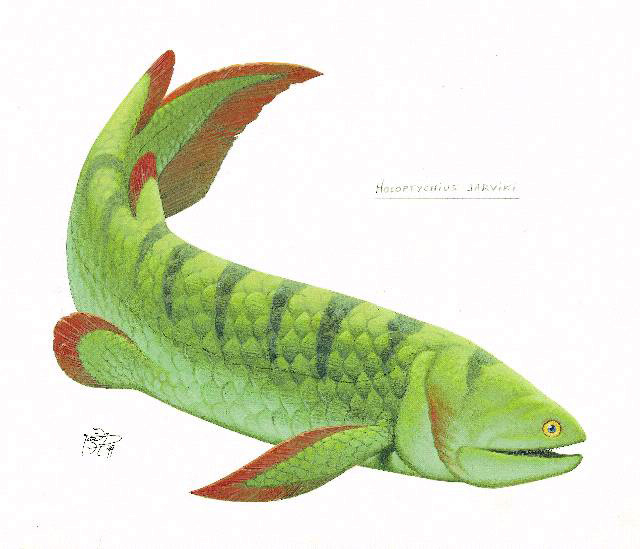Holoptychius
Fish of the genus Holoptychius are relatively common porolepiforms in Upper Devonian rock formations around the world.
 (40 kb) The species at Miguasha, baptized Holoptychius jarviki, is one of the rare porolepiform species whose the entire body is known; more than half the other species, about thirty in all, have only been identified by their scales.
(40 kb) The species at Miguasha, baptized Holoptychius jarviki, is one of the rare porolepiform species whose the entire body is known; more than half the other species, about thirty in all, have only been identified by their scales.
Despite being quite rare, Holoptychius is known at various stages of growth, just like the other porolepiforms at Miguasha, with specimens ranging from 8.5 to 47 cm long.
 (60 kb)The fossils are often preserved in three dimensions, and the most beautiful example, discovered by William Patten a century ago, is kept at the American Museum of Natural History in New York City.
(60 kb)The fossils are often preserved in three dimensions, and the most beautiful example, discovered by William Patten a century ago, is kept at the American Museum of Natural History in New York City.
Holoptychius is recognized by its strongly epicercal tail and rounded fins (except for the pectoral fin which has a stretched leaf-like shape) that are equipped with a very fleshy scale-covered lobe at their base.
 (36 kb)The name of the species, jarviki, pays homage to the Swedish professor Erik Jarvik (1907-1998), who dedicated a large part of his life to studying sarcopterygian fossils from the Escuminac Formation.
(36 kb)The name of the species, jarviki, pays homage to the Swedish professor Erik Jarvik (1907-1998), who dedicated a large part of his life to studying sarcopterygian fossils from the Escuminac Formation.
It is assumed that Holoptychius attained considerable size by the end of the Upper Devonian based on 6- to 10-cm wide scales left behind by some species.

 (40 kb) The species at Miguasha, baptized Holoptychius jarviki, is one of the rare porolepiform species whose the entire body is known; more than half the other species, about thirty in all, have only been identified by their scales.
(40 kb) The species at Miguasha, baptized Holoptychius jarviki, is one of the rare porolepiform species whose the entire body is known; more than half the other species, about thirty in all, have only been identified by their scales.Despite being quite rare, Holoptychius is known at various stages of growth, just like the other porolepiforms at Miguasha, with specimens ranging from 8.5 to 47 cm long.

 (60 kb)The fossils are often preserved in three dimensions, and the most beautiful example, discovered by William Patten a century ago, is kept at the American Museum of Natural History in New York City.
(60 kb)The fossils are often preserved in three dimensions, and the most beautiful example, discovered by William Patten a century ago, is kept at the American Museum of Natural History in New York City.Holoptychius is recognized by its strongly epicercal tail and rounded fins (except for the pectoral fin which has a stretched leaf-like shape) that are equipped with a very fleshy scale-covered lobe at their base.

 (36 kb)The name of the species, jarviki, pays homage to the Swedish professor Erik Jarvik (1907-1998), who dedicated a large part of his life to studying sarcopterygian fossils from the Escuminac Formation.
(36 kb)The name of the species, jarviki, pays homage to the Swedish professor Erik Jarvik (1907-1998), who dedicated a large part of his life to studying sarcopterygian fossils from the Escuminac Formation.It is assumed that Holoptychius attained considerable size by the end of the Upper Devonian based on 6- to 10-cm wide scales left behind by some species.
Site map | Feedback | Links | Sources | Credits
Holoptychius
<< Porolepiforms | Quebecius >>

Title: Reconstruction of the porolepiform Holoptychius jarviki
Author: Illustration by François Miville-Deschênes
Sources: Parc national de Miguasha
Year: 2000
Description:
Reconstruction of the porolepiform Holoptychius jarviki found at Miguasha.

Title: Holoptychius jarviki
Author: Parc national de Miguasha
Sources: Parc national de Miguasha
Year: 2002
Description:
The type specimen of the porolepiform Holoptychius jarviki was discovered at Miguasha by the American paleontologist William Patten in 1912. It is kept at the American Museum of Natural History in New York City.



